Line Cruiser Rivalry: Rinaun and Mackensen
However, this did not happen: almost immediately the field of how orders were issued for the construction of the said four, which was named Rinaun, Rīpals, Resistance, and Edgincourt, World War I broke out. Of course, in 1914, no one could have imagined that many-year nightmare into which Europe would be plunged - it was believed that the war would end in no more than six months or a year, and therefore the ships of the 1914 program did not have time for it, so their construction was frozen . But ... not at the same time.
The fact is that Resistance and Edgincourt were going to be built at the state-owned shipyards of Portsmouth and Devnoport, and with the beginning of the war all preparations for their laying were interrupted immediately - the British reasonably thought that they should focus on completing the construction of many different ships in a high degree of readiness. But two other battleships of the Royal Soveren type were ordered to private firms: Ripals built Palmers in Greenock (near Newcastle), and Rinaun built Fairfield in Gowen (Glasgow). And for some time the Admiralty didn’t stop the works on them, as a result of which “Ripals” was laid, nevertheless, several hundred tons of construction materials were prepared for Rinaun. However, soon their construction slowed down due to the outflow of labor, and then it was completely stopped.
Recall that at this time the Navy Minister, or rather, as it was called in England, the First Lord of the Admiralty was Winston Spencer Churchill, while the First Navy Lord Louis Battenberg commanded the Royal Navy. Shortly after the start of the war, a hail of criticism fell on him (not at all justified), but it seems that the real reason for his resignation was that he bore a German surname, and was almost pure-blooded German. Accordingly, the position of the First Sea Lord turned out to be vacant, and Winston Churchill did not fail to recall his friend and teacher John "Jackie" Fisher. Despite his early seventy-three years old, the admiral still had completely indomitable energy, and his return to the position he held until 1910 was politically acceptable.
Once again becoming the First Sea Lord, D. Fisher developed the most vigorous activity, drawing the attention of the Admiralty to a shortage of light ships - submarines, destroyers, etc. and it was all certainly correct and useful. But D. Fisher felt an incomprehensible, irrational love for the British-type battlecruisers, which he himself created - very fast and heavily armed ships with weakened armor. He was greatly upset by the refusal of the Admiralty from the battlecruisers, and now, having come to power again, he was eager to resume their construction. It was very difficult, since the members of the British Parliament had long ago declared that the battlecruisers, as a class of warships, had completely become obsolete and no longer needed the Royal Navy. But when did this John Arbetnot Fisher stop any difficulties there?
Despite the fact that D. Fisher was distinguished by impetuousness and sharpness of judgments, as well as more and more incontinence breaking through, he remained an excellent politician and very subtly picked up the moment for his proposal, well, its essence was as follows. D. Fisher proposed to build two battlecruisers with 32 node speed and the heaviest cannons that exist (at that time it was obviously 381-mm artillery), while the armor had to remain at the level of "Invincible". Under normal conditions, such a proposal could not be accepted at all, because there was no point in building such ships - they did not have a tactical niche that they could occupy. In other words, there was not a single task for which the fleet would need just such ships. They were needed only by one person in the whole of Great Britain - John Arbetnot Fisher himself. Even Sir Winston Churchill, who was openly inclined to adventures, and at first spoke against them!
However, as we said above, the moment was picked up just fine. First - the August British raid into the Helgoland Bay, in which the support of the five Beatty battlecruisers ensured the destruction of three German light cruisers and victory in battle. It must be said that before the battlecruisers entered the battle, the British affairs were not very good ... Then, the defeat that struck England to the heart was under Coronel, where the Scharnhorst and Gneisenau destroyed the main forces of Admiral Cradock’s squadron. And then - the triumph of "Invincible" and "Inflexible" from the Falklands, who without loss and without serious damage to themselves destroyed the elusive and victorious squad Maximilian von Spee. These events glorified the battlecruisers of England and, as it were, confirmed the correctness of their concept.
And now, immediately after the Falkland battle, John Fisher proposes that Winston Churchill submit to the Cabinet of Ministers a proposal to resume the construction of battle cruisers. However, Sir Winston refused. He told his friend that these ships would divert resources needed for other, more important purposes, and they would still not be ready until the end of the war. Well, D. Fisher immediately found other arguments.
First, he said that the ships would have time to go to war, that the last time he had built the revolutionary Dreadnought in just a year, and in the same time, he was going to create the latest battlecruisers. Secondly, John Fisher drew the attention of W. Churchill to the fact that the liner Lutzov would soon be commissioned in Germany, which could develop at least 28 nodes, while England did not have such ships. And finally, thirdly, the First Sea Lord extracted the "trump ace" - a plan for the landing operation in the Baltic Sea.
As you know, the idea of this operation was utterly extravagant - according to the general plan, the Royal Navy had to overcome the German defense of the Skagerrak and Kattegat straits and invade the Baltic Sea, establishing its dominance there. After that, the British ships would provide the landing of British or Russian troops on the coast of Pomerania, that is, less than 200 km from Berlin itself. John Fisher argued that for such an operation, the Royal Navy would need high-speed and heavily armed ships with a relatively small draft, which were not available.
The plan of the operation looked extremely attractive (on paper) and therefore D. Fisher’s proposals were accepted. After just 10 days after the Falkland battle, the government of England approved the construction of two battlecruisers.
In fact, of course, all the arguments of D. Fisher were not worth a damn. The battle in the Helgoland Bay, of course, confirmed the indisputable fact that the giant ships with heavy guns, which were the battlecruisers, are capable of destroying light cruisers, but what about that? To fight the enemy's light ships, the battlecruisers were too big and expensive. Of course, no one would deny the usefulness of using the battlecruisers as a cover for light forces, well, the British already had ten ships of this class against five (if you count them together with the “Lutzov”) from Germany! No doubt, the battlecruisers had proved their excellent counter-raid qualities, but the fact is that after the death of the Scharnhorst and Gneisenau, the Germans ran out of armored cruisers destined for action in the ocean. “Furst Bismarck” was already quite obsolete, the more or less modern “Blucher” was attached to the battlecruisers, and the rest of the armored cruisers of Germany were created as reconnaissance units in the line squadrons and were not very well suited for ocean raiding. Of course, theoretically, there was still the possibility of sending them to the ocean, but for the confrontation they would have more than enough British armored warriors of the Warrior and Minotaur types, which were superior to the same Roon almost as much as Invincible was superior to Scharnhorst. And this is not to mention the fact that the British could always send a couple of Invincible and Indefatiged types of battle cruisers to communication, and they would still have a numerical advantage over ships of the same class in Germany.
As for the "terrible" German "Luttsov", then the Royal Navy had at least one ship ("Tiger"), which surpassed it in speed, and the other three "343-mm" British battlecruisers, if they were inferior to him, it is completely insignificant. In any case, the Lutzov would have acted as part of the battle cruisers, which leveled its “superiority”, since any squadron was forced to focus on its slowest ship. And the necessity of a low-profile battle cruiser for operations in the Baltic Sea looks very strange - why? In order to "drive" the light forces of the enemy, the battle cruiser is excessively large and powerful, and the enemy's heavy ships in shallow water will not drop in - besides, if we assume a fight with heavy ships in shallow water, then we need speed, not armor. And what else? Support fire assault? So much cheaper monitors will perfectly cope with a similar task.
Even the most cursory analysis of such an operation led to the following - any attempt to break through the British fleet to the Baltic automatically led to a general battle of the German and English fleets - depending on the forces involved in the operation, the Germans would either approach the enemy from the sea or transfer heavy ships to Hochseeflotte Kiel Canal. Such an attempt by England would give the Germans what they dreamed of from the very beginning of the war — the opportunity first to wear down the main forces of the British fleet (in this case, during the last breakthrough of minefields, blocking the entrances to the Baltic), and then, when the forces were more or less equal - to give a general battle. Accordingly, for a similar operation, the British would be much more useful to have a pair of standard battleships than the weakly protected and unable to fight in the cruiser line.
Nevertheless, the pressure and infinite energy of D. Fisher did their job and they received the building permit. However, the First Sea Lord understood very well that he had won only the first round - after all, the project of a new large warship had to go through various approvals, which could “hack” this extravagant idea in any respect. But then the speed of construction promised by D. Fisher came to his aid. In other words, he, hiding behind the need to start construction as soon as possible (and he promised to build battlecruisers in just 15 months!), He had the opportunity to speed up the design procedure to the maximum to exclude any coordination from it that otherwise would have been necessary.
Strictly speaking, the very first "technical task" that D. Fisher gave out to the main shipbuilder d'Einkort said that the First Sea Lord perfectly understood the price for his "arguments" in favor of building battlecruisers. He demanded d'Einkor to design the ship as an improved Invincible with the most heavy artillery of the main caliber, 102-mm anti-mine caliber, 32 node speed, and one of the main requirements was the maximum hull height at the stem, so as to provide the ship with the best seaworthiness . Actually, the project was called: “Ocean battle cruiser“ Radamantus ””, and it was only said about the draft, that: “reduce as much as possible”. As you can see, it was worth only getting the go-ahead for the construction of the battlecruisers, the requirements for them for the Baltic operation have seriously lost their relevance.
D'Einkort tried to satisfy the wishes of the First Sea Lord to the maximum, and the very next day he presented a sketch of the future ship - with a displacement of 18 750 and 32 node speed, the battlecruiser had 152 mm armor, 32 mm deck and armament from two 381- two-axle towers mm guns as well as 20 102-mm guns. The battle cruiser was obviously weak, so D. Fisher, having familiarized himself with the project, ordered to add another 381-mm turret. This is exactly how the Rinauna project turned out.
I must say that d'Eincourt did not like this battlecruiser, and he tried his best to improve it, offering D. Fisher more secure options, but the First Sea Lord was inexorable. Then the shipbuilder went for it and offered to install another 381-mm turret - with such weapons even a completely cardboard ship would still be a grave danger to the German battlecruisers. But nothing happened here either, because only 6 towers could be made on time, but not 8, and D. Fisher left the new battlecruisers with three main-caliber towers and accelerated preparations for construction in every possible way. As a result, the ships were laid just a month after the start of the design, 25 January 1915 r - on the birthday of their “father”, John Arbetnot Fisher.
In some publications, it is indicated that Ripals and Rinaun are battleships of the Royal Sawherin type, completed under a new project, but this is not so. As we said earlier, orders for the construction of the battleships "Ripals" and "Rinaun" were received by the companies "Palmers" and "Fairfield", respectively. But only Palmers managed to lay the ship; however, the company could not build a battle cruiser - it simply did not have a berth of the necessary length. Therefore, the contract for the construction of the Ripals cruiser was handed over to the shipyard John Brown. All the materials prepared by Palmers, which could be used in the construction of a new project ship, were also transferred to it. "Rinaun" built "Fairfield", but, apparently, it was originally laid as a battle cruiser.
Artillery
As we have said, the main caliber of the new British ships were the 381-mm guns, of the same type, which were installed on the queen-battleships Queen Elizabeth and Royal Soverin, which were a masterpiece of naval artillery. The only claim to the "Ripals" and "Rinaun" was the absence of the fourth tower, because, having only 6 guns of the main caliber, the ships had difficulty with long-range fire. But in general, the "big guns" of the "Ripals" and "Rinaun" deserve the highest praise.
But a return to the 102-mm mine artillery is clearly a mistake. Without a doubt, the four-inch projectile was significantly inferior in impact to the six-inch projectile - it was assumed that with one hit of the latter the destroyer with a displacement of up to 1 000 t could be destroyed. Only the number of barrels of 102-mm projectiles could be compensated for. in the salvo. But the number of single-gun 102-mm guns could not be increased to infinity, and the way out was found in the creation of three-gun 102-mm installations. This theoretically ingenious solution, combined with a good location (out of five three-gun and two single-gun installations mounted on each ship, four three-guns and one single-gun could fire on one side) provided for the firing of 13 guns on board — more than double battleships with dozens of 152-mm guns in dungeons. However, the installations themselves turned out to be too heavy - with the weight of the 17,5 and they, at the same time, were not equipped with power drives, so that one could only sympathize with the gunners of these monsters.
But the speed of angular targeting is very important for artillery, firing at nimble and constantly changing course of the destroyers. In addition, for the maintenance of each installation required the calculation of 32 people. Given that the calculation of the 381-mm turret was 64 man, the total number of mine artillery servants was almost equal to the calculations of the main-caliber guns.
The compact dimensions of the installation did not allow the calculations to efficiently serve all three barrels (although each of them had its own cradle) - the gunners simply interfered with each other, therefore the real rate of fire of the three-gun installation was only slightly higher than that of the two-gun. It is also worth noting the poor security of the calculations - they stood quite openly, having only shields, which, of course, could not cover 32 man. All this combined to make the Ripalsa mine artillery nominee for the title of the “worst mine caliber of the Grand Fleet”.
The 102-mm artillery system provided the 10-kg to the projectile with an initial speed of 800 m / s, which is at an elevation angle of 30 hail. allowed to shoot at 66,5 kbt. However, according to the testimonies of the sailors, this range was even unnecessary, since the fall of 102-mm outfits at a distance over 40 kb was no longer visible.
In addition to the aforementioned artillery systems, two 76-mm anti-aircraft guns and four 47-mm salute guns were installed on the "Ripals" and "Rinaun" during construction. They also received two submarine 533-mm torpedo tubes with ammunition in the 10 torpedoes, which, besides, were very unfortunate, in front of the barbet of the main turret bow turret.
Reservation
The armor protection of the Rinaun-type battlecruisers is not that insufficient, it is completely negligible. It is usually claimed that she was at the level of the world's first battlecruisers - the Invinsible ships, but this is not true, because, in fact, the Rinaun was protected much worse than the Invinsibles.
Descriptions armor protection "Rinaun" somewhat differ in different sources. The basis of his body armor was 152 mm belt length 141 m, which began in the middle of the barbet of the bow of the bow and ended in the middle of the barbet of the aft tower. Here, 102 mm of traverse went from the armored belt to the barbets at an angle to the diametral plane, that is, they went from the ship’s side, closing in on the barbets of the bow and stern towers (they are absent in the diagram). At the same time, the nose was protected by 152 mm by armor in the nose from 102 mm of armor belt, and in the rear - by 76 mm. However, these additional armored belts did not reach the stem and the stern stem, being closed by 76-102 mm by traverse, located respectively in the stern and bow. At the same time, the aft traverse was perpendicular to the diametral plane, but the nasal traverse was unclear, and perhaps just like the stern, but according to some other information, its armor plates converged from the left and right side approximately at an angle of 45 hail, which probably provided some the possibility of a ricochet of a large-caliber projectile, when a projectile hits directly into the nose of the ship.
As for the horizontal defense, it was represented by an armored deck that had 25 mm in the horizontal part and 51 mm in the bevel. ("Invincible", respectively, 38 and 51 mm). The only advantage of "Rinaun" was that in the areas of the towers of the main caliber the thickness of the horizontal part of the armor was increased from 25 to 51 mm. Outside the citadel (for 102 mm by traverse), the Rinaun armored deck had 63 mm both in the bow and stern. At Invincible, such protection was only in the stern, and the thickness of the armored deck was not different from the one that protected the citadel (38-51 mm).
Thus, we see that the thickness of the armor protection "Rinaun" and "Invinsible" seems to be the same in thickness, and the "Rinaun" even has a slight advantage - why, then, is his defense worse?
The fact is that the Invincible belt had a height of 3,43 m, and the Rinaun was only 2,74 m. At the same time, the power plant of the Rinaun was, of course, much more powerful than the one on the Invincible. And here's the result - if we recall the Invincible booking scheme, we will see that the horizontal part of the armored deck was located significantly below the upper edge of the 152-mm armor belt.
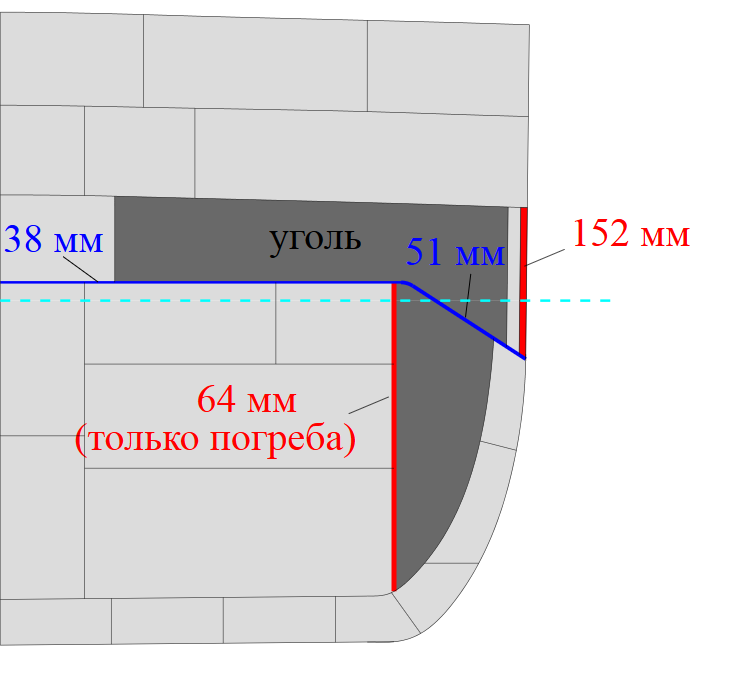
At the same time, the horizontal part of the Rinaun armored decks was exactly at the level of the upper edge of the 152 mm of the armored belt, and even exceeded it in the area of the engine room! In other words, in some cases, and taking into account the flat trajectory of the German shells, they would have to first pierce the 152 mm of armor and only then reach the 38 mm of the section of the armored decks (or 51 of the bevel). At the same time, Rinaun lacked such a section - it had a projectile, which passed along the same trajectory, immediately hit the 51 mm bevel or 25-51 mm deck.
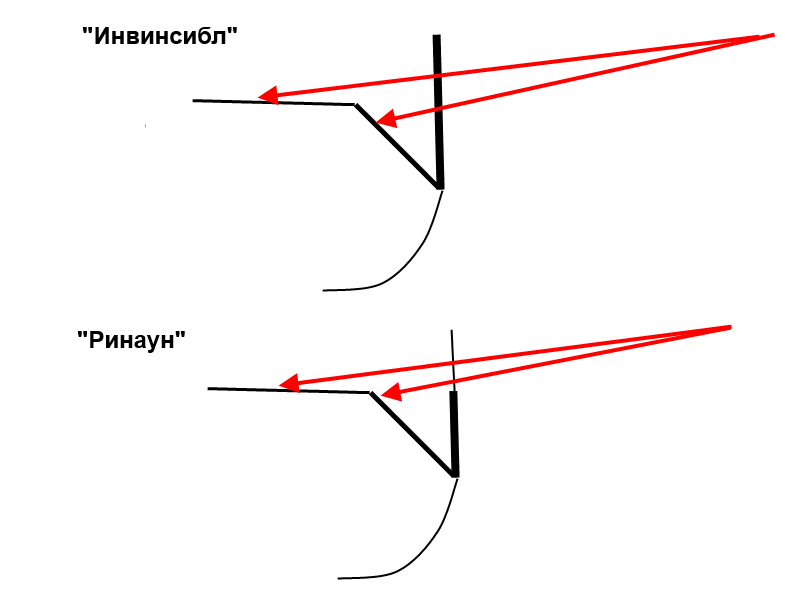
Thus, despite the formal equality of the thickness of the armor plates, the protection of the citadel at the Rinaun was in fact even worse than that of the very first battle cruisers of the Royal Navy!
True, here it is necessary to mention one advantage of horizontal protection "Rinaun" - the fact is that, in addition to the armor deck, "Rinaun" also received enhanced protection of the forecastle deck - sheets of STS were added to it, which were almost the same homogeneous armor . In the area of the barbets of the main-caliber bow towers, the forecastle had insignificant 19 mm, but further into the stern, in the area of boilers and machine rooms, they reached 28-37 mm. However, strictly speaking, all this was not too different from the Invincible 25 mm upper deck.
In principle, if a heavy German projectile would hit the deck of the forecastle, in the area of engine rooms or boiler rooms, then it would most likely detonate, and in this case some hope of keeping its fragments at the lower 25 mm armor deck (especially 51 mm in the areas of the towers of the main caliber) was. But the problem was that the distance between the armor deck and the low side deck was two whole decks - the shell that hit the gate would safely pass the upper level of horizontal protection and easily crush the lower one. The British themselves were well aware that they were doing something wrong, so they tried to somehow strengthen the sides above the armor belt by completing them from two layers of 19 mm steel (total - 38 mm). But, of course, such protection gave hope only to the reflection of fragments of heavy projectiles that exploded from the impact on the water near the ship, and from the projectiles themselves did not create any protection.
In general, one may take the risk of claiming that, as a result of the restrictions imposed by D. Fisher, the Royal Navy received two of the weakest-protected battlecruisers for the entire history British ships of this class. But the First Sea Lord alone could not be blamed for this — it must be stated that the shipbuilders also had their hand in it. So, by refusing to “book” the board above the armored belt and additional protection of the deck of the forecastle, it would be quite possible to strengthen the armored deck to acceptable values, or to increase the height of the armored belt, which would have a very positive effect on the overall level of its protection.
The rest of Rinaun’s booking was also not outstanding - the main caliber towers were the same design as those installed on Royal Soverin, but the thickness of the armor was reduced - the forehead of the towers was only 229 mm (against 330 mm of the original) side plates - 178 mm (280 mm). The barbets were also protected with just 178 mm armor (that is, like Invinsibles). The only advantage over Invincibles was that the barbets were thinned to 102 mm behind the armor-belts, while on the first battlecruisers - half as much, 51 mm. But this was more than compensated by the disadvantage that barbety also had only 38 mm for 102 mm overboard, that is, in this region, the total feed tube protection didn’t even reach 152 m ... The bow conal tower was protected by 254 mm armor, the stern - only 76 mm, and more chimneys got cover from 38 mm armor plates. That, in general, was all.
Chassis
It should be noted that in the “Booking” section, we did not report anything about the anti-torpedo bulkhead, but this is because it was not on the “Rinaun” and “Repalse”. But the ship for the first time in the British fleet received boules integrated into the hull design. It must be said that this design, in the opinion of the admirals, provided no worse and perhaps better protection than the anti-torpedo bulkhead: the resulting additional body volume was used to store liquid cargo (including oil), although it was divided into several compartments . As a result, despite the fact that the bulkhead thickness was 8-19 mm of ordinary shipbuilding steel, their total thickness was 50 mm. Well, given the fact that between them there was a liquid that absorbs the energy of an explosion, the effectiveness of such protection significantly exceeded the usual one, with an armored bulkhead. Also, the boules allowed to reduce the draft of the ship, but I must say that here the British did not achieve too much success - if the "Tiger" had a draft in the normal displacement of 8,66 m, then in the "Reeps" and "Rinaun" - within 8,1 m. Often the indicated draft in 7,87 and so refers to the empty ship.
Power plant
The project was supposed to use a lightweight power plant with increased steam parameters, but due to the haste of building ships, it had to be abandoned. As a result, the machines and boilers were structurally similar to those installed on the “Tiger”, and this was not a good solution, because such a power plant had too much weight for its power. More modern boilers would free up at least 700 t to enhance the same booking ... however, such an installation also had its advantages, because Tiger’s cars and boilers proved to be very reliable units.
The rated power of the mechanisms should have been 110 000 hp, the forced 120 000 hp, while at the nominal power and normal displacement (26 500 t), 30 knots were expected to reach. In fact, "Ripals" with a displacement close to full (32 29 t) and power in 900 119 hp developed 025 knots, and “Rinaun” with weight in 31,7 27 t and power 900 126 hp - 300 knots.
Project Evaluation
RIPALS completed the 21 tests of September, and Rinaun - 28 November 1916, when both W. Churchill and D. Fisher had already lost their posts. As is known, the concept of the British battlecruiser did not withstand testing by the Jutland battle, so the attitude to the new ships from the sailors was appropriate: they were given the status of “urgently in need of modernization” and were not included in the Grand Fleet under this specious pretext. In other circumstances, they might have been left at the wall until the end of the war, but the British absolutely did not like that they, in fact, remained with three "343-mm" cruisers (the ships preceding them with the 305-mm guns were considered practically lost combat value) against the four German battle cruisers. At the same time, in the very near future, Hohzeeflott should have received the Hindenburg instead of the drowned Lutzow, and in England they were sure that the first Mackensen was about to enter service. Therefore, the British found that they were still needed to “Ripals” and “Rinaun”, and the newly built ships immediately went to the first (but not the last) modernization in their life, which was completed in late spring 1917. before, but precisely until this time work was carried out.
Therefore, it should be said that Ripals and Rinaun joined the fleet in spring 1917. I must say that the hasty modernization, during which ships were added to 504 and armor, was not solved, of course, by their security issues. The horizontal armor section above the engine (but not boiler) compartments was reinforced from mm 25 to mm 76. The armored decks from the barbat of the bow turret to the 102 mm traverse (in the bow) and from the barbet of the stern tower to 76 mm the traverse (in the stern) were reinforced from 25 mm to 63 mm. The deck in the stern outside the citadel was brought from 63 mm to 88 mm. The horizontal protection was also strengthened over the cellars of the main caliber towers, but not the armor, but the lower deck - its thickness was adjusted to 51 mm.
Without a doubt, these measures somewhat increased the armor protection of the "Ripals" and "Rinaun", but, of course, it was "a little better than nothing." Protecting these two battlecruisers did not look enough even against 280-mm projectiles, not to mention 305-mm. In other words, they could fight with “Seidlits”, “Derflinger” or (all the more!) With “Mackensen” before the first hits to the location of key mechanisms (power plant, towers, barbets, cellars of the main caliber, etc.) after which, almost guaranteed to receive severe or even fatal damage. No doubt, the German ships were vulnerable to 381-mm projectiles, but on the whole their armor provided much greater combat stability than the armor of Rinaun type cruisers.
In other words, during the war years, the British built two ships, completely unresponsive to the tasks they faced.
But what is interesting ... Years passed, and in the future, during the Second World War, the Ripals and Rinaun became one of the most useful ships of the fleet. However, there is nothing strange here. The very high speed they received “at birth” gave the linear cruisers a good modernization stock — despite a significant increase in body armor, they remained fast enough to fight modern cruisers. At the same time, most of the German ships that could have sent to fight in the ocean are light and heavy cruisers, “pocket” battleships were “legitimate game” for the Ripals and Rinaun, and thanks to enhanced armor protection and very powerful 381 -mm guns, they remained extremely dangerous even for the Scharnhorst and Gneisenau. In fact, the only ships of Hitler for which the Ripales and Rinaun were themselves "legitimate game" were the Bismarck and the Tirpitz, but that was all. In the Mediterranean, they could not fight only with the newest Italian battleships of the type "Vittorio Veneto", but had the opportunity to avoid combat, in the Pacific Ocean would represent a worthy response to the modernized Japanese Congo-class battlecruisers.
It can be stated that the vicious concept and absolute discrepancy to the tasks set by the First World War did not at all make Ripals and Rinaun useless ships, but this happened in the future and solely due to the restrictions of naval forces that could not exist predict in advance. In other words, Ripals and Rinaun, despite all their flaws, served the glorious service of good old England, but the merits of their creators are not in this.
Продолжение следует ...
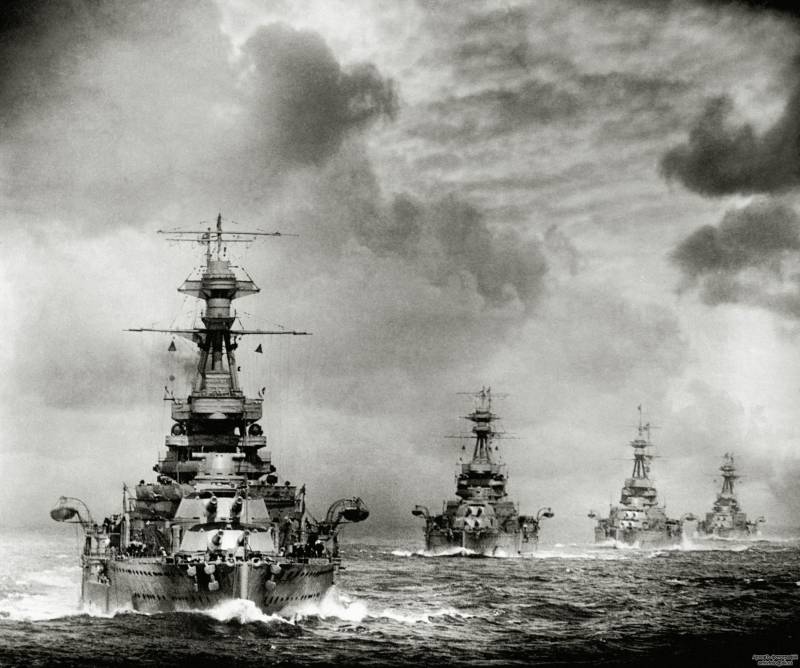
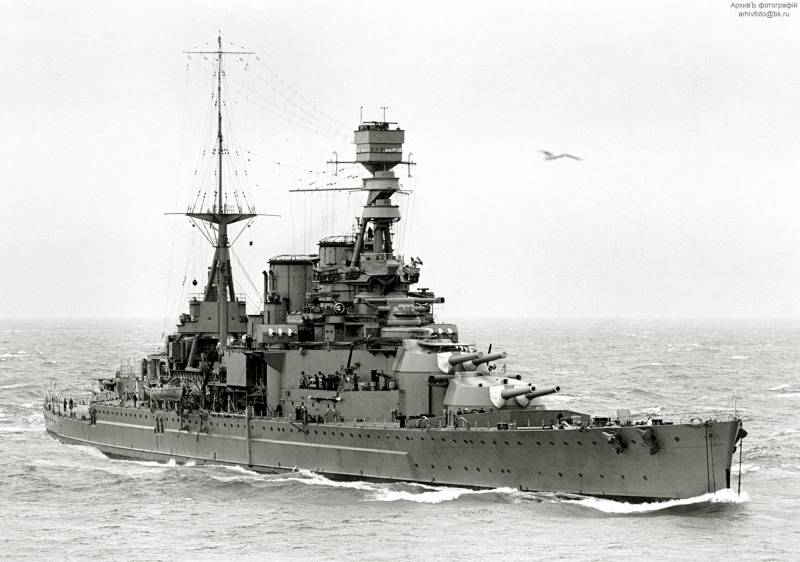
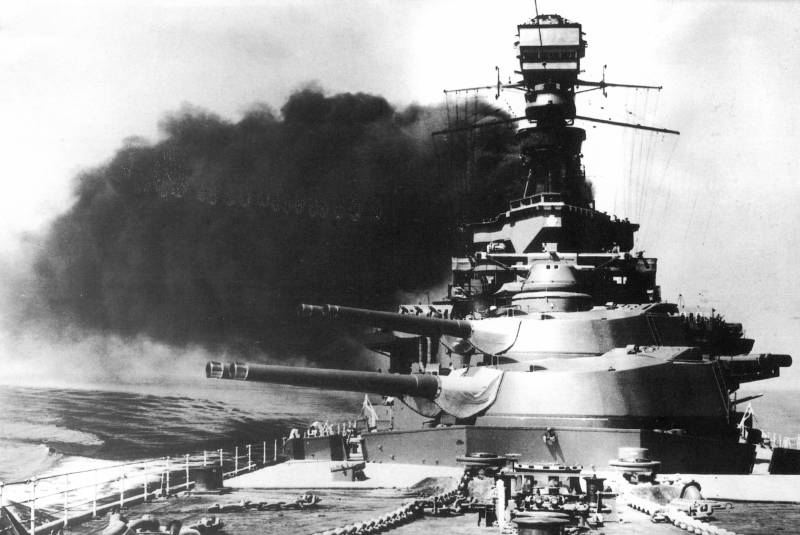
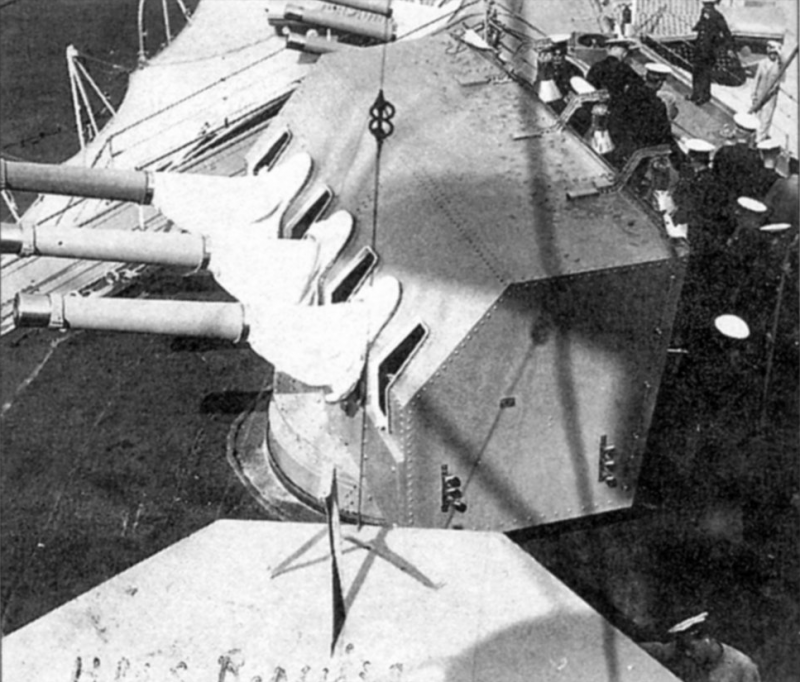
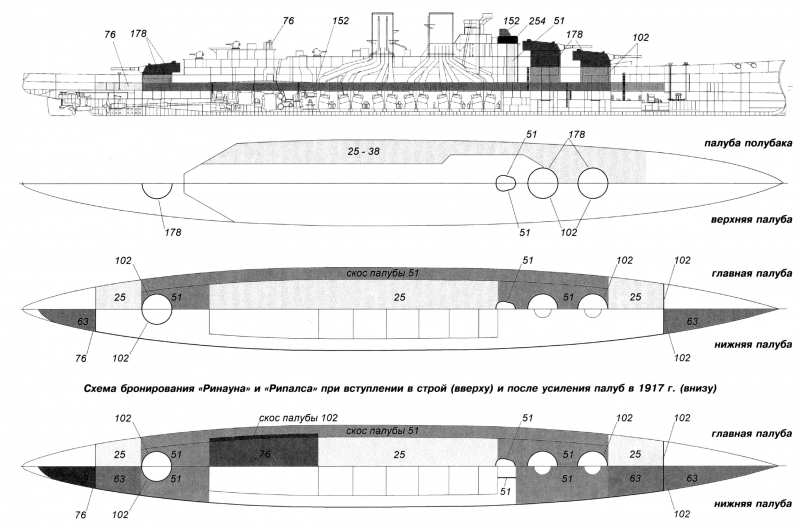
Information